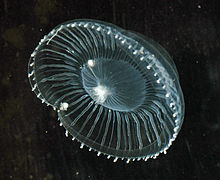Aequoreidae
| Aequoreidae | |
|---|---|
 |
|
| Aequorea victoria (the "crystal jelly") with two amphipods | |
| Scientific classification | |
| Kingdom: | Animalia |
| Phylum: | Cnidaria |
| Class: | Hydrozoa |
| Order: | Leptomedusae |
| Suborder: | Conica |
| Family: |
Aequoreidae Eschscholtz, 1829 |
| Genera | |
Aequoreidae is a hydrozoan family. There are approximately 30 known species found in temperate and tropical marine coastal environments. Aequoreids include Aequorea victoria, the organism from which the green fluorescent protein gene was isolated.
Only the polyp stages of Aequorea species have been observed. The colonies are covered with chitinous periderm and can be either prostrate or erect with weak or sympodial branching. Young hydranths possess hydrothecae with a closing structure called operculum, which consists of several relatively long triangular folds that meet together in the centre when a disturbed polyp contracts. Because the operculum is quite fragile, hydrothecae of old polyps usually have only a small chininous collar remaining. Comparatively large cylindrical gonothecae are attached to the colony with a thin peduncle. Commonly only one medusa develops in each gonotheca.
Mature aequoreid medusae are diverse in shape, from lens-like to conical, and in size. The smallest, Aequerea parva is only 0.6 cm in diameter, while the largest, Rhacostoma atlanticum, can reach 40 cm in diameter. The medusae of most species are between 5 and 15 cm in diameter.
Aequoreidae includes the following genera:
...
Wikipedia
